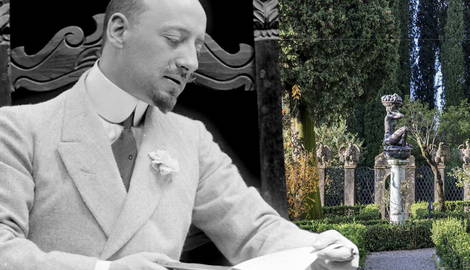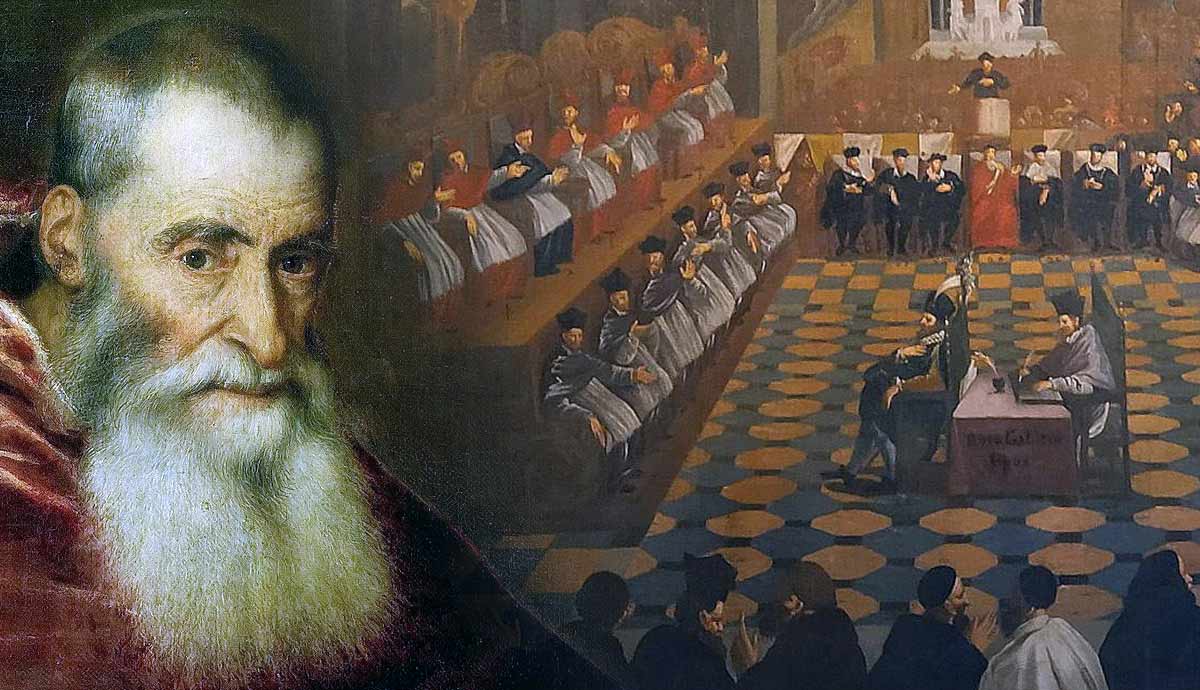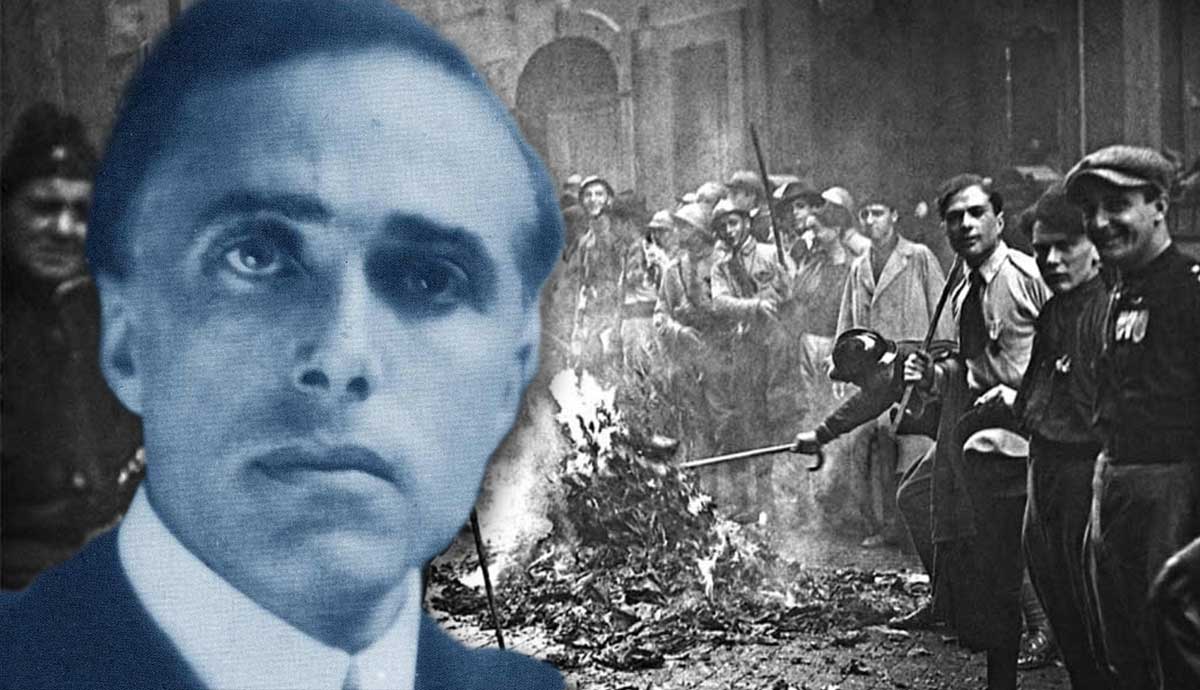
“One must make one’s life as one makes a work of art,” declares Andrea Spinelli, the main character of Gabriele D’Annunzio’s Il Piacere (The Child of Pleasure). D’Annuzio himself lived by this motto. A prolific writer and poet, Gabriele D’Annunzio was also skilled in self-promotion. Over the years, he created the so-called vivere inimitabile (inimitable living), a lavishly decadent lifestyle that turned him into a celebrity. He became known as Il Vate (the Bard) of Italian literature. After World War I, he also became actively involved in politics. His 1919 occupation of Fiume (present-day Rijeka) foreshadowed many aesthetic, political, and cultural components of Italian Fascism.
Gabriele D’Annunzio: Aesthete and Poet

The son of a wealthy Pescara landowner, Gabriele D’Annunzio published his first collection of poems, Primo Vere (In Early Springs), in 1879, when he was only 16. After graduating from the prestigious Reale Collegio Cicognini in Prato, Tuscany, D’Annunzio enrolled in the Faculty of Literature of the University of Rome. However, the young poet was more interested in the literary salons of the capital than in his academic studies, and he left the university before completing his degree.
In Rome, D’Annunzio began his collaboration with Cronaca bizantina (Byzantine Chronicle), a literary and art journal edited by Angelo Sommaruga, where he published his first prominent collection of poems, Canto novo (New Song). Influenced by Italian poet Giosuè Carducci, D’Annunzio wrote sensuous verses celebrating the mystical fusion between man and nature. Meanwhile, his libertine, lavish lifestyle fostered his reputation as a “dissipated aesthete.” Rejecting the conventional distinction between good and evil, D’Annunzio aimed to live according to an amoral set of purely aesthetic norms.

Gabriele D’Annunzio described his unconventional lifestyle in his first (and most famous) novel Il piacere (The Child of Pleasure), where Andrea Sperelli, the main character, engaged in amorous exploits and sensual experiences in his quest for the ultimate erotic and artistic pleasure. A vivid erotism is also at the heart of Alcyone, D’Annunzio’s most famous collection of poetic works. Published in 1904, this series of poems evoked sensual fragrances and harmonious sounds of summer. During these years, inspired by his affair with Italian actress Eleonora Duse, Gabriele D’Annunzio also wrote a number of successful plays, including Francesca da Rimini and La figlia di Iorio (The Daughter of Jorio).
Gabriele D’Annunzio between Nietzsche & Wagner: The Poetics of the Superman

In 1894, Gabriele D’Annunzio published Il trionfo della morte (The Triumph of Death), the first “novel of the Superman.” Along with Le vergini delle rocce (The Maidens of the Rocks) and Il fuoco (The Flame of Life), the novel cemented D’Annunzio’s position as the most prominent exponent of Italian Decadentism. According to many scholars, D’Annunzio’s “novels of the Superman” were the first step in the aestheticization of politics that culminated in Mussolini’s Fascist regime.

D’Annunzio’s “decadent” novels are full of Nietzschean heroes who despise altruism and seek power and pleasure through violent actions. However, their vital force (free of any moral restraint) is torn between the contrasting life instinct and the Dionysian death drive. Most importantly, D’Annunzio’s Superman is at the same time a poet and a political leader.
In The Third Life of Italy, the Vate asked: “Where is the leader that we could follow, capable of reconciling grand acts with grand conceptions … the leader capable of shaking and arousing to their very depths the dormant forces of regeneration?”
D’Annunzio believed that only the poet-Superman could play that role. The ultimate embodiment of D’Annunzio’s concept of the poet as an agitator of the masses was Stelio Effrena, the amoral hero of Il fuoco. “There really was beauty in the masses,” muses Stelio in a passage, “and only a poet or a hero could draw out flashes of it.”

According to D’Annunzio, the mobilization of the masses should be achieved with the creation of a Wagnerian total work of art. A fusion of poetry, dance, and music, the Gesamtkunstwerk would be a “monumental revelation of the ideal towards which the genius of our own race is being led.” Then, it is not a coincidence that Stelio Effrena is one of the pallbearers of Wagner’s coffin in Il Fuoco. As the prophet of Germany’s new music is laid to rest, the poet-Superman will birth a glorious Third Rome from the ashes of the materialistic and utilitarian values of the liberal society, symbolized by a decadent Venice.
Gabriele D’Annunzio in World War I

The literary successes were not enough to sustain his extravagant lifestyle. Thus, Gabriele D’Annunzio moved to France to avoid his numerous creditors in 1910. There, he collaborated with composers Claude Debussy and Pietro Mascagni. He returned to Italy at the outbreak of World War I to urge his country to enter the conflict. In 1915, when Italy opted in favor of intervention, D’Annunzio enlisted in the army as a volunteer. After serving in several branches, he was then appointed to the air force, where he lost sight in his right eye after being wounded in combat. During his hospitalization, D’Annunzio wrote Notturno (Nocturne), a lyrical prose exploring his inner self and describing his fragmentary impressions and visions during his temporary blindness.

After being cleared for active duty, D’Annunzio pursued a couple of individual, daring actions that gained him a reputation as a war hero. On the night between February 10 and 11, 1918, along with Costanzo Ciano and Luigi Rizzo, D’Annunzio sneaked into Bucari Bay with three MAS motorboats to attack the Austrian fleet anchored there. The pranksters also left three bottles adorned with the colors of the Italian flag in the bay. The event became known as beffa di Buccari (Mockery of Buccari). On this occasion, the poet, inspired by the acronym MAS (torpedo-armed motorboat), coined the motto Memento audere semper (always remember to dare).
In August 1918, D’Annunzio organized another bold military exploit when, along with eleven other fighter pilots, flew over Vienna to drop 40,000 propagandistic leaflets urging the enemy capital’s citizens to surrender. “Long Live Liberty! Long Live Italy! Long Live the Entente!” read the last lines.
The Endeavor of Fiume (1919-1920)

In the aftermath of World War I, the terms of the Treaty of Versailles left many Italians, especially war veterans, feeling betrayed and outraged. In particular, the nationalist front denounced the reduced territorial gains granted by the treaty. For many advocates of Italy’s intervention in the war, the conflict was the perfect opportunity to claim the “unredeemed” (irridenti) territories that were still part of the Austro-Hungarian Empire, thus completing the Risorgimento.
D’Annunzio gave voice to the widespread discontent of veterans and embittered nationalists. “Victory of ours,” exclaimed D’Annunzio in a rousing 1918 speech, “you shall not be mutilated.”
Benito Mussolini, then the leader of the newly-born Fascist movement, incorporated the concept of “mutilated victory” into his ideology. He also expressed his contempt at being forced to “breathe the stench of peace” Indeed, according to his point of view, “not only has our war not ended, it has only now reached its climax.”
On September 12, 1919, D’Annunzio decided to put his words into action: he marched to the city of Fiume with two thousand war veterans, known as arditi, to annex the territory to the Kingdom of Italy. He proclaimed the birth of the Reggenza Italiana del Carnaro (Italian Regency of Carnaro) from the city governor’s mansion: “Ecce homo,” theatrically exclaimed the poet. D’Annunzio’s Endeavour of Fiume was one of the first attacks against the European order established by the Versailles Treaty.

For the following 15 months, D’Annunzio ruled Fiume as “Commander” of the Regency. News of his enterprise echoed across the globe. In 1920, the so-called Charter of Carnaro organized the new political order of the state. Written by Aleste De Ambris and D’Annunzio, the charter combined elements of republicanism, national syndicalism, and corporatism. Scholars have long puzzled over the political nature of the Regency. On the one hand, the charter granted freedom of speech and declared the equality of all citizens before the law. On the other hand, the constitution introduced the figure of the Commander, a sort of military dictator who would rule the state in the event of “extreme danger.” D’Annunzio described the Commander as “one who can unite the force of the people for war and victory.”
In terms of foreign policy, Fiume rejected the new international order based on Woodrow Wilson’s Fourteen Points. In particular, D’Annunzio created the League of Fiume as an alternative to the League of Nations. According to the poet, the new organization was formed “out of the will of all the spirits that yearn for the liberty of all people mangled by injustice and oppression.” In this sense, D’Annunzio presented the League of Fiume, based on a nationalist form of sovereignty, as a criticism of the democratic powers of the West (“an immense Jewish bank serving the ruthless transatlantic plutocracy”).
Gabriele D’Annunzio & the Aestheticization of Politics

In Fiume, D’Annunzio introduced many aesthetic and ideological trends that would later become central elements of Mussolini’s Fascist movement and regime. For example, the habit of raising the right arm in the Roman salute began in Fiume. Similarly, the shout “Eia eia alalà!” (Achilles’ battlecry in the Iliad), a popular fascist motto, was coined by D’Annunzio. Most importantly, the endless parades, balcony speeches, violent rhetoric, and cult of personality that took place in Fiume laid the basis for the politics of spectacle of Italian (and European) Fascism. The origins of Mussolini’s corporatism can also be traced back to the experiment of Fiume. Indeed, the Charter of Carnaro established a corporatist state where the workers were organized into nine corporations representing the different sectors of the Regency’s economy.

On November 12, 1920, Italy and Yugoslavia signed the Treaty of Rapallo, thus formally resolving the dispute over Fiume. When D’Annunzio rejected the treaty, Giovanni Giolitti, Italy’s prime minister, ordered the army to remove the poet’s legionaries from the city. However, in 1924, Mussolini signed a new agreement with Yugoslavia and annexed the Free State of Fiume to the Kingdom of Italy.

Though D’Annunzio had a crucial impact on the Fascist regime, his relationship with Mussolini was strained. Though the Duce appointed him president of the Royal Academy of Italy in 1937, D’Annunzio was largely marginalized by the Fascist regime. He died from a brain hemorrhage in 1938 in his villa at Gardone Riviera, a small town on Garda Lake. In 1930, the poet handed it over to the Italian State. Today, the Vittoriale degli Italiani is one of the most popular tourist destinations in northern Italy.










